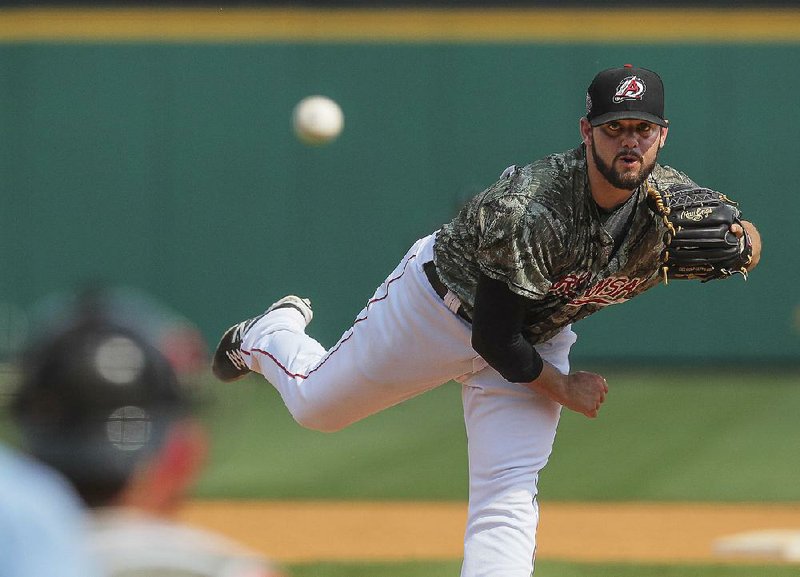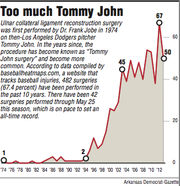Cam Bedrosian had pitched 12 professional innings when he stepped onto a mound in Arizona for a spring training game in 2011.
Only 19 years old at the time, Bedrosian had already missed most of spring because of a sore elbow that had been treated the winter before. But Bedrosian was still on track to begin his first full pro season less than a year after being selected as a first-round draft pick.
The Los Angeles Angels thought so highly of his right arm that could throw a baseball almost 100 mph, they gave him a $1.116 million signing bonus.
But when Bedrosian threw his first pitch that spring, it was clocked at 92. Then 89. Then 85. He finished the inning -- and remembers not giving up a run -- but alarm bells were blaring.
"It just hurt every time," he said. "Just had nothing."
Bedrosian's next 12 months were spent in a way that has become all too familiar for pitchers of all types. He had an MRI that revealed a torn ulnar collateral ligament, which connects the upper arm to the forearm and is one of a pitcher's most vital assets.
That meant UCL reconstructive surgery -- commonly referred to as Tommy John surgery -- a procedure that replaces the torn UCL with a ligament or tendon from another part of the body.
Bedrosian's surgery was performed April 29, 2011, by Dr. James Andrews in Birmingham, Ala. Bedrosian didn't throw a ball for five months and waited six more to throw from a mound. A month after that, on May 1, 2012, he appeared in a game for the first time since surgery, pitching 4 1/3 hitless innings at Class A Cedar Rapids.
"My arm has felt great since then," said Bedrosian, who has been on the Arkansas Travelers' roster for most of this season. "I haven't had any problems."
Nearly half of the 49 Class AA players participating in tonight's Texas League All-Star game at Dickey-Stephens Park in North Little Rock are pitchers, like Bedrosian, and increasingly susceptible to the injury and surgery endured by Bedrosian, one of 24 pitchers named as All Stars.
Bedrosian is both an example of how pitchers can be forced to turn to Tommy John surgery at an early age, but also an example of how the surgery can put careers back on track.
Bedrosian, 22, has bounced back so well from his surgery, for 18 days earlier this month he was pitching out of the Los Angeles Angels' bullpen for the first time.
He returned to Arkansas on Sunday and has regained his spot on the All-Star roster, a position earned by his work earlier this season for the Travs, when Bedrosian struck out 31 and compiled a 1.40 ERA with 9 saves in 19 1/3 innings.
Pitchers like Travelers left-hander Michael Roth, who will start tonight for the North Division, are well aware what happened to Bedrosian will likely happen to them, eventually.
"It's a matter of time," Roth said. "Not if you're going to have it, it's more like when you're going to have it. You just hope you're in the big leagues when it happens."
AIR OF INEVITABILITY
The statistics back up Roth's concern.
According to baseballheatmaps.com, a website that tracks baseball injuries, more than 600 Tommy John surgeries have been performed since 2000, and of the 677 pitchers to appear in a major league game in 2013, more than 20 percent have had it. According to the same website, the surgery was performed just four times in the decade after Dr. Frank Jobe first performed it in 1974 on Tommy John, then with the Los Angeles Dodgers.
So far this season, 51 players -- 47 pitchers, 2 catchers, 1 third baseman and 1 outfielder -- have had the surgery, including Angels reliever Sean Burnett, who spent two weeks with the Travs in May on a rehab assignment.
Tonight's All-Star roster would have included two more prospects, Tulsa's Daniel Winkler and Midland's Raul Alcantara, but both have had the surgery. Winkler was selected to the team and Alcantara was on track with a 2.29 ERA through three starts.
Springfield's Kyle Hald was in the stands charting pitches June 7 in Tulsa and watched Winkler throw his last pitch.
"His arm just went dead," said Hald, who will pitch for the North team tonight. "It's a sickening feeling. You don't wish that on anybody."
Hald's concerns fall in line with Roth's. Both have seen it too much to think it won't eventually happen to them.
"You don't think about it every day, but it's in the back of your mind," Hald said. "You never know when it's going to happen."
The increase in the surgeries can be viewed as a positive.
Bedrosian, for one, has bounced back so well he spent most of this month in the big leagues.
St. Louis Cardinals ace Adam Wainwright and Stephen Strasburg of the Washington Nationals have each had it.
"It's more of an option now," said Joe Griffin, the Travs' strength and conditioning coach. "They know a guy will come back and pitch. Back in those days, they didn't know what to expect. Now they know it's not the end."
That means, the upward trend in surgeries likely won't slow down.
"Ten years from now," Bedrosian said, "almost every pitcher will have to have it."
VARYING THEORIES
Theories as to what causes elbows to wear down are almost as numerous as the victims.
Travelers Manager Phillip Wellman, a three-decade veteran of the minor leagues, blames it on poor mechanics and an overuse in youth leagues.
"You've got to give your body time to heal, grow, rest," he said. "If you've got poor pitching mechanics and all you do is play nine months out of the year, all you're doing is reinforcing poor pitching mechanics."
Travelers pitching coach Pat Rice said increased weight training in the upper body has put more stress on the UCL, which doesn't get stronger no matter how many weights are lifted.
"You can't make it stronger," he said. "It is what it is."
Pete Harnisch, whose 14-year major-league career ended with Tommy John surgery in 2001, said poor conditioning puts more stress on the arm.
"Day after I pitched, I used to take off and run for an hour -- 5, 6 miles," said Harnisch, now a roving pitching instructor for the Angels. "I don't see anybody doing it [now]."
Jim Brower, the Northwest Arkansas Naturals' second-year pitching coach, said pitchers don't preserve their arms with sights set on the big leagues.
"There is no nice and easy anymore," he said. "Conditioning helps, but at the end of the day, you're doing an act that is difficult on the arm."
The American Sports Medicine Institute, based in Birmingham, Ala., recently published its stance on its website, saying the amount of pitchs made by youth players, poor mechanics and poor physical conditioning all contribute to arm troubles later in their careers. The group suggested youths play multiple positions, take more warmup throws and participate in multiple sports.
Each theory, considering the experience of those delivering them, can be met with some acceptance.
But a problem arises when looking at those who have blown out their elbows: Having to endure Tommy John surgery might end up being the only connection they have.
Bedrosian, the son of 1987 National League Cy Young winner Steve Bedrosian, said he started pitching when he was 10 or 12 years old, and pitched through each spring and summer, throwing fastballs in the mid-90s by the time he was in the 10th grade.
"I was throwing too hard before my body was all the way matured," he said.
Even if the overuse theory were true, it wouldn't explain the injury of Wellman, who had the surgery in 1999 as a 37-year-old third-base coach at Class AA Chattanooga, or Carmine Giardina, a 26-year-old left-hander in his second season with the Travelers.
Giardina had his surgery three weeks before Bedrosian, and the two went through much of the rehab process together. Little else is similar, though.
Giardina played hockey and basketball, as well as baseball, while growing up in Tampa, Fla., and didn't regularly pitch until he was a junior in high school. Plus, Giardina has been used mostly as a relief pitcher, exclusively so over the past three seasons, a path that has presumably left less wear-and-tear on his elbow.
"I wasn't a guy that pitched that long and I still had it," Giardina said. "When it's going to pop, it's going to pop."
SO MANY BULLETS
Wellman said he worries about the stress being placed on the arms of youth pitchers, and Rice and Brower each said the concern about elbow injuries is high. But when their job is to funnel pitchers through the system, they're almost limited to counting pitches and crossing their fingers.
"In order to get better, you have to throw," said Brower, who pitched most of nine big-league seasons with a blown UCL he didn't know about. "There's no getting around that."
Brower said the Kansas City Royals, the Naturals' parent club, have no formal protocol as to how to help pitchers avoid Tommy John surgery. Wellman said there isn't one with the Angels, either, other than an organized maintenance program.
It's common in the minor leagues for starting pitchers to be placed on strict pitch counts to start the season.
Naturals' starters were limited to 75-80 pitches their first two outings, then 85-90 for two outings, then 95-100, Brower said. A starter can be pushed beyond 100 pitches, but rarely will one throw more than 110.
Travs' starters mostly rest the day after each start, then throw a bullpen session the next day of about 45-50 pitches at about 60-70 percent effort. Roth said his maintenance program includes sprints, and long toss the day after his start.
"We do all we can do," Wellman said.
Rice, who said he has seen the protection of pitchers heighten over the past 30 years from when he pitched for the Arkansas Razorbacks in the 1985 College World Series, said at times it comes down to chance.
"There's nothing that we feel like we're doing that's hurting them," he said. "So is it just bad luck? Some of it, yeah. I think there's no doubt about that."
Meaning, in the end, there might not be anything to get around this reality: The UCL is delicate, the arm motion of a pitcher is violent.
"There's so many bullets in everybody's arm," Harnisch said. "Nobody knows when the last one is, so you throw them all with conviction and when that day is it is."
Sports on 06/24/2014


